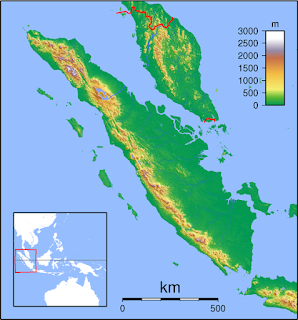Indonesia Travel Destinations: Gunung Leuser National Park
 |
| pic. google.com |
Geography
 |
| pic. wikipedia, google.com |
Gunung Leuser National Park is 150 km long, over 100 km wide, and mostly mountainous. About 40% of the park, mainly in the north-west, is steep, and over 1,500 m in elevation. This region is billed as the largest wilderness area in Southeast Asia, and offers wonderful trekking. Around 12% of the park, in the lower southern half, is below 600 m above sea level. Eleven peaks are over 2,700 m. Mount Leuser (3,119 m) is the third-highest peak on the Leuser Range. The highest peak is Mount Tanpa Nama (3,466 m), the second-highest peak in Sumatra after Mount Kerinci (3,805 m).
Ecology
 |
| pic. wikipedia, google.com |
Gunung Leuser National Park is one of the two remaining habitats for Sumatran orangutans (Pongo abelii). In 1971, Herman Rijksen established the Ketambe Research Station, a specially designated research area for the orangutan. Other mammals found in the park are the Sumatran elephant, Sumatran tiger, Sumatran rhinoceros, siamang, Sumatran serow, sambar deer and leopard cat.
After researchers put 28 camera traps in July 2011, 6 months later the researchers found one male and six females, and predicted the population is not more than 27 Sumatran rhinos, of which the total population is predicted to be around 200 in Sumatra and Malaysia, half the population of 15 years ago.
Water supply
 |
| pic. wikipedia, google.com |
Tourism
 |
| pic. wikipedia, google.com |
Low-impact ecotourism can be one of the most important sustainable, nonconsumptive uses of Leuser, thereby giving local communities powerful incentives for conservation. Given the opportunities to view wildlife such as orangutans, some experts view ecotourism as a major potential source of revenue for communities living around Leuser.
Tangkahan trekking
 |
| pic. wikipedia, google.com |
A 7- to 8-hour drive from Medan, Tangkahan is visited by 4,000 foreign tourists and 40,000 domestic/local tourists a year. Modest inns are available, but generation set electricity is limited. Many Tangkahan people nowadays work for tourism and avoid illegal logging, with education sometimes past the elementary school, but with training, they can serve the tourists well. All tourists should enter Tangkahan Visitor Center first, and choose the various packages, with up to 4 day and 3 night packages, the prices are fixed even for the porters. Trekking can be done by foot or using elephants.
Biodiversity
 |
| pic. wikipedia, google.com |
People living in areas with a high biodiversity value tend to be relatively poor. Hence, the highest economic values for biodiversity are likely to be found within institutions and people in wealthy countries. Funds can come from several sources, including bioprospecting, the GEF, and grants from international NGOs (with donations possibly being proportional to biodiversity value).
Source

0 komentar:
Post a Comment